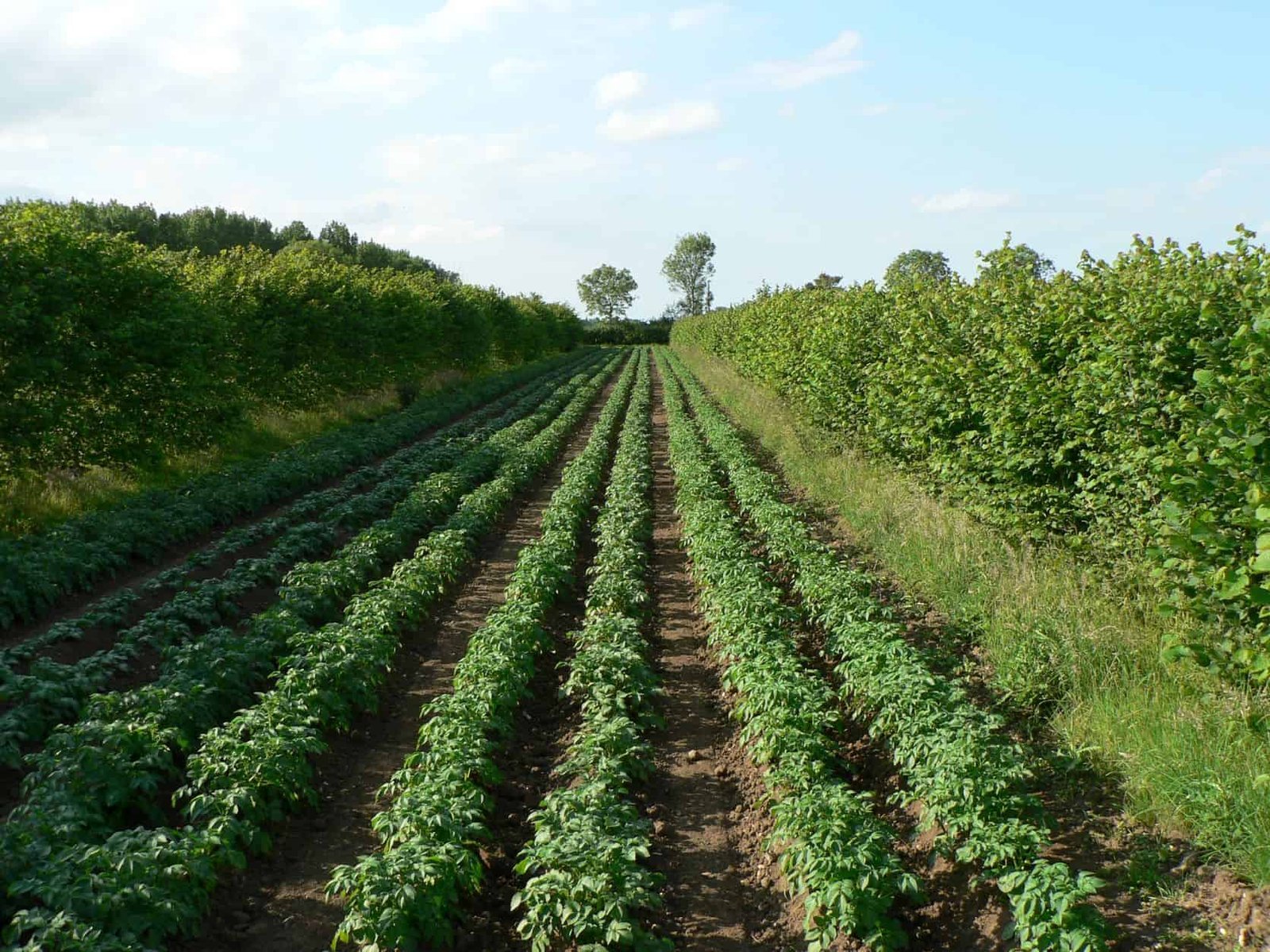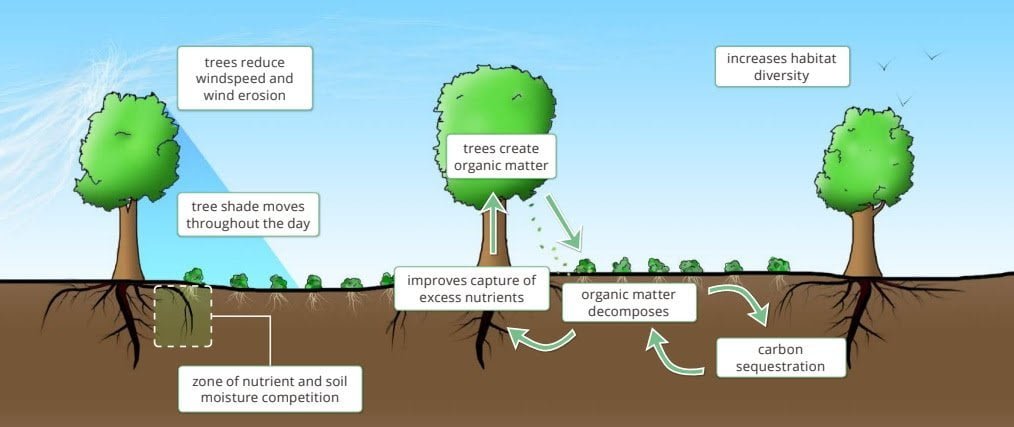
Summary of Contents
Introduction
Ever wondered if trees could be your farm’s best friend? Enter alley cropping—a sustainable farming practice where trees or shrubs are planted in rows with crops growing in the alleys between them. This method not only helps with soil health but also offers extra income and improves biodiversity. I’ve found it especially useful here in Northeast India, where maintaining healthy soil is key to farming success. Today, we’ll dive into what alley cropping is, how it works, and why you should consider trying it on your farm.
What is Alley Cropping?
Alley cropping is the practice of planting trees or shrubs in rows with wide spaces (or alleys) between them. In these alleys, farmers grow crops like maize, wheat, or vegetables. The trees provide benefits like shade, reduced wind speed, and improved soil structure, while the crops grow in the spaces between.
It’s like having a diverse team where each member (tree or crop) brings something valuable to the table—some crops help feed the soil, while trees provide stability and long-term growth. Together, they create a resilient farming system.
Step 1: Choose the Right Trees (Your Farm’s Guardians)
The first step in alley cropping is selecting the right trees or shrubs. They should provide benefits like improving soil health, fixing nitrogen, or offering a secondary product like fruit or timber. For example, trees like Leucaena or Gliricidia are often used because they help enrich the soil and grow quickly. These trees are great companions for annual crops like maize or beans.
Think of your trees as guardians—they protect your crops and offer long-term stability while improving the health of your soil.
Step 2: Plan Your Layout (Spacing is Key)
Next, plan your layout. The trees should be planted in rows, leaving enough space in between (the alley) for your crops to grow. Typically, the spacing between tree rows ranges from 4 to 10 meters, depending on the crops you intend to grow.
Imagine it like setting up rows of tall protectors, with your crops thriving in the safe space between. Too little space can lead to competition for sunlight, water, and nutrients, so plan wisely.
Step 3: Plant Your Crops in the Alley
Once your trees are established, it’s time to plant your crops in the alleys. Choose crops that grow well in partial shade if your trees are tall, or opt for those that can benefit from the microclimate created by the trees, like vegetables or cereals. The trees will help reduce wind speed and prevent soil erosion, creating a better environment for your crops to thrive.
Step 4: Manage Resources (Water, Nutrients, and Care)
Trees and crops will both need water and nutrients, so manage your resources carefully. Using mulch and drip irrigation can help ensure both your trees and crops get enough water without over-stressing the land. Keep an eye on soil moisture and add organic fertilizers when necessary to maintain soil fertility.
Benefits of Alley Cropping

1. Prevents Soil Erosion
The trees’ roots help bind the soil, preventing it from washing away during heavy rains—a common issue in places like Northeast India where monsoons can lead to erosion. The rows of trees act like natural barriers that slow down water flow, giving it time to absorb into the ground.
2. Improves Soil Fertility
Many trees used in alley cropping, like Leucaena or Acacia, fix nitrogen in the soil, improving fertility for the crops planted in the alleys. This natural nitrogen boost means you rely less on chemical fertilizers.
3. Provides Additional Income
The trees themselves can offer a secondary income. Depending on what you plant, you might harvest fruits, timber, or fodder from the trees. In this way, you’re not just growing crops, you’re growing long-term investments.
4. Reduces Wind and Temperature Stress
Trees in alley cropping reduce wind speeds, which is especially useful for protecting fragile crops. The shade from the trees also helps reduce soil temperature and moisture loss, creating a more stable environment for crops.
5. Enhances Biodiversity
Alley cropping introduces more diversity to your farm, attracting beneficial insects and birds. The added biodiversity can help control pests naturally and create a healthier farming ecosystem overall.
Challenges of Alley Cropping
As great as alley cropping sounds, it does come with challenges:
1. Tree Competition: Trees and crops might compete for water and nutrients, especially if not spaced properly.
2. Management Complexity: Alley cropping requires careful planning and resource management, such as watering both trees and crops without overloading the soil.
3. Time Investment: Trees take time to mature, so the full benefits of alley cropping may take a few years to be realized.
Best Practices for Alley Cropping
1. Choose Fast-Growing, Nitrogen-Fixing Trees: Pick trees that grow quickly and enrich the soil. Leucaena, Gliricidia, and Acacia are excellent choices because they fix nitrogen, which improves soil health for your crops.
2. Maintain Proper Spacing: Space your trees according to the type of crops you’re growing. Too close, and your crops will struggle to get enough sunlight. 4 to 10 meters of spacing between tree rows is ideal.
3. Practice Regular Pruning: Keep your trees pruned so that they don’t overshadow the crops in the alleys. Pruning also provides additional organic material that you can use as mulch or compost.
Economic Insights: How Alley Cropping Boosts Profits
Incorporating trees into your farming system can boost your income in several ways. Not only do your crops benefit from the improved soil health and protection, but the trees themselves can provide valuable products like timber, fodder, or fruit. Alley cropping diversifies your income streams, making your farm more financially resilient. Plus, by improving soil fertility naturally, you can cut down on chemical fertilizer costs, further increasing your profitability.
In Northeast India, where farmers often face unpredictable weather and difficult terrain, alley cropping offers a sustainable and profitable solution for long-term farm productivity.
Conclusion: Alley Cropping for a Sustainable, Profitable Future
Alley cropping is a powerful way to protect your soil, improve yields, and make your farm more resilient. By planting trees in rows with crops in between, you create a farming system that benefits from natural biodiversity and soil enrichment while reducing the risks of erosion and crop failure.

For small farmers in Northeast India, where the landscape can be challenging, alley cropping provides a sustainable path to better yields and greater profits. If you’re looking to make your farm more sustainable and profitable, consider giving alley cropping a try—you’ll be amazed at the long-term benefits!
FAQ Section
Where is alley cropping used?
Alley cropping is used in both tropical and temperate regions, particularly in areas where farmers want to prevent soil erosion and improve crop resilience. It’s commonly used in places like Northeast India and other regions with heavy rainfall or sloped terrain.
How does alley cropping prevent soil erosion?
The trees’ root systems bind the soil together, preventing it from being washed away during heavy rains. The rows of trees act as natural barriers, slowing down water flow and giving the soil more time to absorb water.
What does alley cropping mean?
Alley cropping is the practice of planting rows of trees or shrubs with crops grown in the wide spaces, or alleys, between them. This method improves soil health, reduces erosion, and provides additional income from the trees.
What trees are used in alley cropping?
Common trees used in alley cropping include Leucaena, Gliricidia, Acacia, and Sesbania. These trees are often nitrogen-fixing, helping to improve soil fertility.
Which tree is best for agriculture?
Leucaena is considered one of the best trees for agriculture due to its fast growth, nitrogen-fixing properties, and its ability to provide timber, fodder, and shade.
